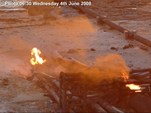In August 2007 the Australian equestrian industry was struck by its first-ever outbreak of Equine Influenza (EI). The Federal Government’s report on the incident has been released and has significant lessons for several reasons.
Australia has been proud of its biosecurity and customs service for decades. As an island nation at the end of the world, there is a level of purity in its ecology that needs to be preserved (even though there were many earlier mistakes – foxes, rabbits, cane toads – to name a few). The country’s pride was obviously out of touch with reality as Justice Callinan was highly critical of the Australian Quarantine Inspection Service. Few government reports have included the clarity (or bluntness) of phrase as this report includes.
“The objective of biosecurity measures at a post-arrival quarantine station for animals, such as Eastern Creek, is to prevent the escape of disease that might be present in the station. It is therefore essential that people and equipment having contact with the animals are adequately decontaminated before leaving the station. That was not happening at Eastern Creek in August 2007. Had such biosecurity measures been in place, it is most unlikely that there could have been any escape of equine influenza from the Quarantine Station.
That such measures were not being implemented was a consequence of a number of acts and omissions on the part of various employees and officers of AQIS at different levels of that organisation and over a number of years.”
As the media reports appeared and the Agriculture Minister, Tony Burke, spoke passionately about the need to review the entire biosecurity process, farmers and other were thanking their luck that the outbreak was EI and not Foot & Mouth or other equally nasty infection.
Indonesia, a consistent sufferer of Avian Influenza, is only a few hundred kilometres away. If Australia had a poultry industry on its northern shores, would the Government’s approach to quarantine inspecton be different?
Callinan goes on to depict an organisation of mismanagement and is not afraid to point the finger of blame and responsibility. He summarises:
“What I describe bespeaks an organisation that lacked clear lines of communication between those responsible for formulating procedures and work instructions and those responsible for implementing them; one in which there was insufficient training and education in relation to the procedures and instructions to be followed; one in which there was no checking to ensure that those procedures and instructions were being implemented; and one in which any business plan or other reporting system did not alert senior management to these failures.”
For OHS professionals and risk managers, these systemic failures would fit with too many other risk management failures. It is too easy a criticism to say that the organisation was devoid of a safety culture. In the case of quarantining possible infectious animals, the organisation and process was inept.
A few years ago, Chris Maxwell undertook a review of Victoria’s OHS regime and stated that he thought citizens should be able to expect government departments to be exemplars of workplace safety. It is an expectation that may be unfair in many areas but when an organisation has been urging the public to be super-diligent over the importation of items that could potentially decimate agricultural industries, and then fails disastrously itself, maybe the public campaign funds could have been better spent inside the organisation.
ABC Radio report – http://mpegmedia.abc.net.au/news/audio/pm/200806/20080612-pm01-horseflu.mp3
Government response http://www.daff.gov.au/__data/assets/pdf_file/0008/690704/ei-response.pdf


